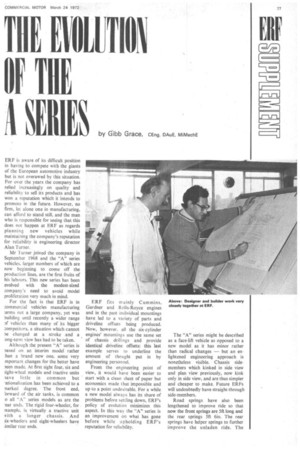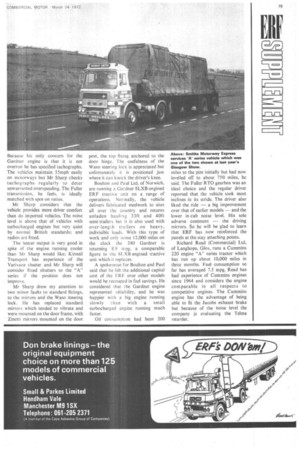THE BUM OF THE
Page 79

Page 80

Page 81

If you've noticed an error in this article please click here to report it so we can fix it.
A SERIES by G-ibb Grace, CEng, DALIE,
ERF is aware of its difficult position in having to compete with the giants of the European automotive industry but is not overawed by this situation. For over the years the company has relied increasingly on quality and reliability to sell its products and has won a reputation which it intends to promote in the future. However, no firm, let alone one in manufacturing, can afford to stand still, and the man who is responsible for seeing that this does not happen at ERF as regards planning new vehicles while maintaining the company's reputation for reliability is engineering director Alan Turner.
Mr Turner joined the company in September 1968 and the "A" series vehicles, larger numbers of which are now beginning to come off the production lines, are the first fruits of his labours. This new series has been evolved with the modest-sized company's need to avoid model proliferation very much in mind.
For the fact is that ERF is in ciommercial vehicles manufacturing terms not a large company, yet was building until recently a wider range af vehicles than many of its bigger ompetitors, a situation which cannot be changed at a stroke and a long-term view has had to be taken.
Although the present "A" series is based on an interim model rather :ban a brand new one, some very mportant changes for the better have leen made. At first sight four, six and :.ight-wheel models and tractive units lave little in common but 'ationalization has been achieved to a narked degree. The front end, brward of the air tanks, is common .o all "A" series models as are the .ear ends. The rigid four-wheeler, for xample, is virtually a tractive unit with a longer chassis. And ix-wheelers and eight-wheelers have iimilar rear ends. ERF fits mainly Cummins, Gardner and Rolls-Royce engines and in the past individual mountings have led to a variety of parts and driveline offsets being produced. Now, however, all the six-cylinder engines' mountings use the same set of chassis drillings and provide identical driveline offsets: this last example serves to underline the amount of thought put in by engineering personnel.
From the engineering point of view, it would have been easier to start with a clean sheet of paper but economics made that impossible and up to a point undesirable. For a while a new model always has its share of problems before settling down, ERF's policy of evolution minimizes this aspect. In this way the "A" series is an improvement on what has gone before while upholding ERF's reputation for reliability.
The "A" series might be described as a face-lift vehicle as opposed to a new model as it has minor rather than radical changes — but an enlightened engineering approach is nonetheless visible. Chassis sidemembers which kinked in side view and plan view previously, now kink only in side view, and are thus simpler and cheaper to make. Future EREs will undoubtedly have straight-through side-members.
Road springs have also been lengthened to improve ride so that now the front springs are 5ft long and the rear springs 5ft 6in. The rear springs have helper springs to further improve the unladen ride. The narrower chassis means that the rear springs can be mounted outboard of the chassis and thus chassis height can be usefully dropped.
The cab, too, has many improvements to aid driver comfort. Cab trim is extensive and very tastefully done, and at the same time serves to keep the noise level down. The dashboard has been dramatically improved by the adoption of a wood-grained finish , and matched instruments; it is not only more attractive but also more functional and informative.
Over the next 12 months or so all ERF production will be of the rationalized "A" series type. Up to a point this does mean that the company will no longer be able to build a vehicle to a customer's particular requirements. However, the great majority of operators will find what they want within the basic model range and the list of standard factory-engineered options. Less common requirements can be ordered on a special equipment basis but at a true cost to the customer.
In the past, special vehicles have been underpriced to the detriment of the more standard vehicle. The new policy will foster a better basic vehicle at a more stable price without penalizing the operator who wants a special vehicle and is prepared to pay the right price for it.
ERF makes four, six and eight-wheelers but as Alan Turner points out, the top weight vehicle has always been its best seller. At the moment the 4 x 2 32-ton-gcw tractive unit is the company's best seller but as we saw at the 1971 Scottish Show the company offers a 32-ton-gcw drawbar unit which has already aroused interest from some operators. The ultimate ratio of vehicle types will depend on how the C and U Regulations develop, for at 38 tons gcw and above the truck and drawbar configuration becomes a very much better bet.
Whatever the future holds, and Mr Turner with the rest of the industry believes the maximum weight must go' up one day, ERF is in a strong position. It has a good name among hauliers, and as the "A" series shows it has an engineering department which makes itself felt. When the time comes the "A" series will no doubt have a worthy successor.
To find .out how the "A" seric copes in service I talked to a numbei of operators who run them. MI Robert Sharp, junior, of Kinnei Transport Co Ltd, Edinburgh, ha! two Gardner 8LXB-engined tractive units used on double-shift trunking So far they have clocked only 50,00( miles between them and it is still ear13 days but already Mr Sharp "delighted" with their performance.
Running at 30 to 31 tons gcw thi 240 hp Gardners are returning a fue consumption of 8 mpg and using veil little oil. Early on the engines seemee to use a quart of oil very quickly afte being replaced but when this quar was not replaced consumption wa virtually negligible. The dipstick! have now been re-marked with ERF approval and oil consumption minimal from the start. Mr Sharp ha experience of 150 and 180 Gardne engines and is sure the 240 will provi to be as great a success in due course Because his only concern for the Gardner engine is that it is not overrun he has specified tachographs. The vehicles maintain 55mph 'easily on motorways but Mr Sharp checks tachographs regularly to deter unwarranted overspeeding. The Fuller transmission, he feels, is ideally matched with spot-on ratios.
Mr Sharp considers that the vehicle provides more driver comfort than do imported vehicles. The noise level is above that of vehicles with turbocharged engines but very quiet by normal British standards; and radios are fitted.
The heater output is very good in spite of the engine running cooler than Mr Sharp would like; Kinneil Transport has experience of the Varivane shutter and Mr Sharp will consider fitted shutters to the "A" series if the position does not improve.
Mr Sharp drew my attention to two minor faults to standard fittings, to the mirrors and the Waso steering lock. He has replaced standard mirrors which tended to vibrate and were mounted on the door frame, with Zinetti mirrors mounted on the door post, the top fixing anchored to the door hinge. The usefulness of the Waso steering lock is appreciated but unfortunately it is positioned just where it can knock the driver's knee.
Boulton and Paul Ltd, of Norwich, are running a Gardner 8LXB-engined ERF tractive unit on a range of operations. Normally, the vehicle delivers fabricated steelwork to sites all over the country and returns unladen hauling 33ft and 40ft semi-trailers but it is also used with over-length trailers on heavy, indivisible loads. With this type of work and only some 12,000 miles on the clock the 240 Gardner is returning 8.9 mpg, a comparable figure to the 61.XB-engined tractive unit which it replaces.
A spokesman for Boulton and Paul said that he felt the additional capital cost of the FRF over other models would be recouped in fuel savings. He considered that the Gardner engine represented reliability, and he was happier with a big engine running slowly than with a small turbocharged engine running much faster.
Oil consumption had been 200 miles to the pint initially but had now levelled off to about 750 miles, he said. The Fuller RTO gearbox was an ideal choice and the regular driver reported that the vehicle took most inclines in its stride. The driver also liked the ride — a big improvement over that of earlier models — and the lower in-cab noise level. His sole adverse comment — the driving mirrors. So he will be glad to learn that ERF has now reinforced the panels at the stay attaching points.
Richard Read (Commercial) Ltd, of Langhope, Glos, runs a Cummins 220 engine "A" series tractor which has run up about 10,000 miles in three months. Fuel consumption so far has averaged 7.5 mpg. Read has had experience of Cummins engines since 1964 and considers the engine comparable in all respects to competitive engines. The Cummins engine has the advantage of being able to fit the Jacobs exhaust brake but because of the noise level the company is evaluating the Telma retarder.




















































































































































